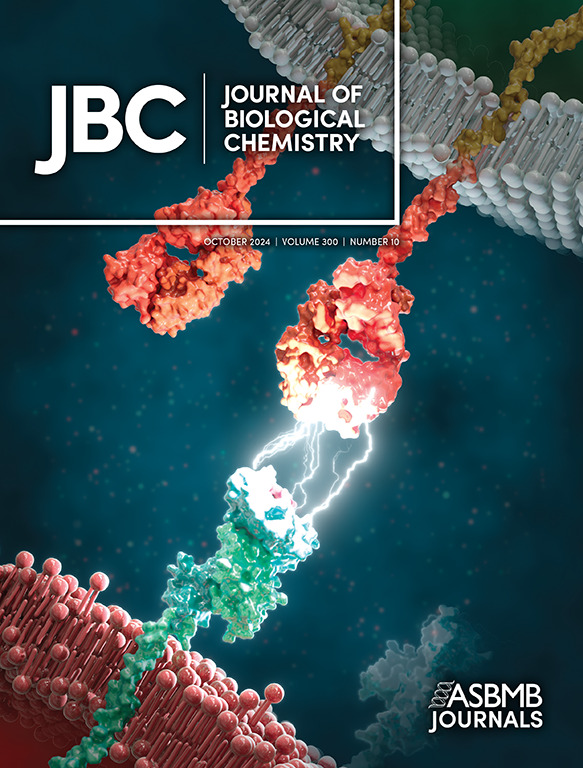Targeted incorporation of collagen IV to the basement membrane: a step forward for developing extracellular protein therapies
IF 4
2区 生物学
Q2 BIOCHEMISTRY & MOLECULAR BIOLOGY
引用次数: 0
Abstract
The collagen IV scaffold serves as a fundamental structural unit of the basement membrane (BM). Understanding its structure, assembly, and function is essential for tissue engineering, design of organoid models, and developing therapies for diseases such as Alport syndrome, Gould syndrome, psoriasis, eye abnormalities, hearing loss, and others where collagen IV is required for structural integrity and functionality of the BM. The collagen IV molecule is a 400 nm long heterotrimer, comprising non-collagenous 1 (NC1), collagenous, and 7S domains. The assembly of the collagen IV scaffold involves oligomerization of the C-terminal NC1 and the N-terminal 7S domains, along with lateral associations within the collagenous domain. However, the detailed architecture and assembly mechanisms of the collagen IV scaffold remain unclear. Here, we investigated the potency and mechanism of recombinant single-chain NC1 trimer incorporation into the collagen IV scaffold. We discovered that the NC1 trimer influences the overall assembly of the basement membrane by affecting the quality of the developing collagen IV scaffold in a dose-dependent manner, without impacting already established scaffolds. This interference occurs through the hexamerization of supplemented NC1 trimers with endogenous NC1 domains, as the NC1 trimer becomes sulfilimine crosslinked with the existing chains. Overall, the single-chain NC1 trimer of collagen IV is crucial for developing novel extracellular therapies in two main ways: 1) facilitating the delivery and incorporation of functional replacements like collagen IV fragments, and 2) inhibiting the formation of new basement membranes in conditions such as tumor growth and detrimental vascularization.IV型胶原蛋白与基底膜的靶向结合:细胞外蛋白治疗的新进展
胶原IV支架是基底膜(BM)的基本结构单元。了解IV型胶原蛋白的结构、组装和功能对于组织工程、类器官模型的设计以及诸如Alport综合征、Gould综合征、牛皮癣、眼睛异常、听力损失等疾病的治疗至关重要,而其他疾病需要IV型胶原蛋白来维持基底膜的结构完整性和功能。胶原IV分子是一个400 nm长的异源三聚体,包括非胶原1 (NC1),胶原和7S结构域。IV型胶原支架的组装涉及c端NC1和n端7S结构域的寡聚化,以及胶原结构域内的横向关联。然而,IV型胶原支架的详细结构和组装机制尚不清楚。在这里,我们研究了重组单链NC1三聚体掺入胶原IV支架的效力和机制。我们发现NC1三聚体以剂量依赖的方式通过影响正在形成的胶原IV支架的质量来影响基底膜的整体组装,而不会影响已经建立的支架。这种干扰是通过补充的NC1三聚体与内源性NC1结构域的六聚化发生的,因为NC1三聚体与现有链交联成为亚砜胺。总的来说,IV型胶原的单链NC1三聚体对于开发新的细胞外疗法至关重要,主要有两个方面:1)促进IV型胶原片段等功能替代品的传递和结合,2)在肿瘤生长和有害血管化等条件下抑制新基底膜的形成。
本文章由计算机程序翻译,如有差异,请以英文原文为准。
求助全文
约1分钟内获得全文
求助全文
来源期刊

Journal of Biological Chemistry
Biochemistry, Genetics and Molecular Biology-Biochemistry
自引率
4.20%
发文量
1233
期刊介绍:
The Journal of Biological Chemistry welcomes high-quality science that seeks to elucidate the molecular and cellular basis of biological processes. Papers published in JBC can therefore fall under the umbrellas of not only biological chemistry, chemical biology, or biochemistry, but also allied disciplines such as biophysics, systems biology, RNA biology, immunology, microbiology, neurobiology, epigenetics, computational biology, ’omics, and many more. The outcome of our focus on papers that contribute novel and important mechanistic insights, rather than on a particular topic area, is that JBC is truly a melting pot for scientists across disciplines. In addition, JBC welcomes papers that describe methods that will help scientists push their biochemical inquiries forward and resources that will be of use to the research community.
 求助内容:
求助内容: 应助结果提醒方式:
应助结果提醒方式:


